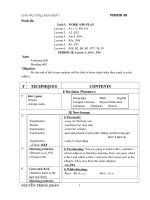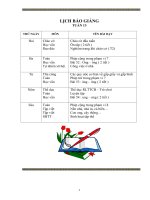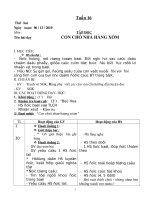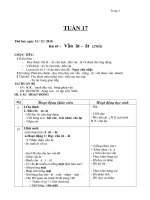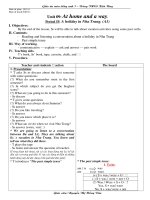giao an anh 7 tuan 34 moi 3 cot
Bạn đang xem bản rút gọn của tài liệu. Xem và tải ngay bản đầy đủ của tài liệu tại đây (109.45 KB, 18 trang )
<span class='text_page_counter'>(1)</span><div class='page_container' data-page=1>
<b>Week 3</b>
<b>Unit 1 : Back to school </b>
<b>b. names and addresses </b>
<b>Period 7:</b> <b>B6 + B7 + remember</b>
Date of planning: 17/8/2009
<b>I. Objectives: </b>
By the end of the lesson, Ss will go on practising about the personal
information such as: name, address, age … and practice listening comprehension
Grammar points: “How far is it from… …to ?”
Skill: Listening comprehension and Speaking
<b>II. Teaching aid : book, posters , tape and chalk</b>
<b>III. anticipated-problem.</b>
Ss may have difficulty in listening to the tape , so teacher should be ready to
help them.
<b>Iv. PROCEDURE</b>
<b>* Check the old lesson.</b>
T: call ss to go to the board to read and translate the dialogue between Nam and
Hoa into vietnamese.
Ss: listen and do as the request.
<b>Time</b> <b>Steps</b> <b>Work</b>
<b>Arrangements</b>
5’
7’
15’
<i><b>* Warm up</b></i><b> : </b>
T: greeting and call some Ss to answer some
questions about themselves
+ What is your full name / family name / first
name?
+ How old are you ?
+ Where do you live ?
+ How far is it from your house to school?
+ How do you go to school ?
+ Who do you live with?
Ss: listen and answer the questions
<b>* B6. listen and write.</b>
Pre –<b> listening:</b>
T: introduce the name of each place and the new
words
Ss: listen and note down
+ distance : khoảng cách
+ Is Lans house near or far from school ?
T: give some questions to help Ss to focus on the
tapescript
<b>While- listening.</b>
T: play the tape twice and then call Ss to give their
answer
Ss: listen and write four distances
T: play the tape again in order to check
Ss: listen and note down
a) School to Lan’s house : 300 meters
b) Lan’s house to post office : 700 meters
c) School to movie theater : 3 kilometers
d) Movie theater to post office : 2 kilometers
+ Tape – transcript.
<b>Lan</b><i>: My English book is still at home.</i>
<b>Ho</b><i>a: How far is it from school to your house, </i>
<i>Lan?</i>
<b>Lan</b><i> : It s about 300 meters. I can go home at </i>’
<i>recess.</i>
<b>Hoa</b><i>: I need some stamps . Where is the post office,</i>
<i>Ln?</i>
.
Teacher
Students
Teacher
Wholeclass
Teacher
Individual
</div>
<span class='text_page_counter'>(2)</span><div class='page_container' data-page=2>
8’
10’
3’
2’
<b>Lan</b><i>: It s not far from my house .Come with me.</i>’
<b>Hoa</b><i>: How far is it from your home?</i>
<b>Lan</b><i>: Only 700 meters.</i>
<i> *</i>
<b>Lan</b><i>: Let s go to the movies.</i>’
<b>Hoa</b><i>: OK. Where is the movie Theater?</i>
<b>Lan</b><i>: It s in the center of Ha Noi.</i>’
<b>Hoa</b><i>: How far is it from school?</i>
<b>Lan</b><i>: It s three kilometers. We can take the bus </i>’
<i>number two.</i>
<i> *</i>
<b>Hoa</b><i>: Oh! My letter is in my pocket.</i>
<b>Lan</b><i>: We can post it after the movie.</i>
<b>Hoa:</b><i> How far is it from the movie theater to the </i>
<i>post office?</i>
<b>Lan</b><i>: About two kilometers.</i>
<b> Post listening :</b>
T: Use the distances you have just listened to make
dialogues
Ss: do as the request .
* B7 . Survey.
T: request Ss to look at the form and give the
questions used to get those information
Ss : recall to say
Complete the form by using questions you have
learned.
T: What is your name?
Where do you live?
How do you go to to school?
How far is it from your home to school?
T: arrange the class to complete the survey form
Ss: do as the request.
<i><b>* Wrapping- up.</b></i>
T: revise the structure “ How far is it from …. to
.?
……
Ss:: listen and remember
<i><b>* Homework</b>.</i>
T: write 5 questions and answers about the
distances that you know . Prepare the next lesson “
Unit 2: A1,2,3”
Ss: listen and note down
Pairwork
Pairwork
Teacher
students
Teacher
Students
<b>REMARK :</b>
...
<b>Unit 2: personal information</b>
<b> Period 8 : section A : telephone numbers </b>
<b> Lesson 1: a1+ A2 + A3 </b>
Date of planning : 20/8/2009
<b>I. Objective : </b>
By the end of the lesson, Ss will know the cardinal numbers well, especially the
complex numbers such as : 0, 88, 1133 … and they can know how to ask and
answer about their phone number well.
Grammar points : saying the phone numbers and use the question “ What is your
telephone number?”
Skill : Listening telephone numbers and practicing pair work or group work
<b>II. Teaching aid : book, posters , tape and chalk</b>
<b>III. anticipated-problem.</b>
</div>
<span class='text_page_counter'>(3)</span><div class='page_container' data-page=3>
<b>IV. PROCEDURE : </b>
* Check the old lesson.
T: call Ss to go to the board to introduce about themselves.
Ss: listen and go to the board to do as the request.
<b>Time</b> <b>Steps</b> <b>Work</b>
<b>arrangements</b>
3’
4’
5’
<i><b>* Warm-up</b></i>.
T: Make some questions and ask Ss to answer the
questions.
? Does your family have a telephone at home?
? Can you give me your telephone numbers?
Ss: listen and answer the questions.
<b>Activity 1: A1. Read</b>
<b>* Pre- reading.</b>
T: introduce the topic of the lesson in English or
Vietnamese
Ss: listen to the introduction
“ Nowadays , telephone has been very popular in our
social communication. Thus, it is necessary for English
learners to have a good skill of using and understanding
telephone in their study . We will deal these matters in
this lesson”
T: request Ss to look at the book at the page 19 and give
a question about it
Ss: listen and answer the question
T: Now look at the book and answer
+ where is this page from ?
It is from a telephone directory.
T: explain the meaning of the underlined word
Ss: note down
+ telephone directory:
<b>* While-reading.</b>
T: guide Ss how to read the telephone numbers
Ss: listen and practice
T: guide Ss to read some telephone numbers in the book
Ss: do Ss the request
T: explain some other difficult numbers such as : 800,
222, 000, 111.
How to read the telephne numbers :
eg : 8 237 789
8 224 203
8 721 577
8 843 881
Stop after reading the code and then read every three
numbers . 22 : two - two or double two
T: guide Ss the task of the activity
Ss: listen to the task
T: play the tape 2 or 3 times
Ss: listen
T: ask Ss to compare their listening result and then call
Ss to give their answers
Ss: do as the request
T: play the tape again to give the correct answers
T: ask Ss to look at the book and give some introducing
questions
Ss: listen and answer the questions
Now read the telephone in the book
S1:: read the addresses
S2: read the telephone numbers
<b>* Post- reading.</b>
Teacher
Students
Teacher
Whole class
Individual
Teacher
Individual
Teacher
Whole class
Pair work
</div>
<span class='text_page_counter'>(4)</span><div class='page_container' data-page=4>
5’
10’
5’
5’
3’
3’
2’
T: guide Ss and then play the tape
Ss: listen
T: give some questions about the dialogue
Ss: listen and try to answer
<b>Activity 2: A2. Listen and write the telephone </b>
<b>numbers</b>
T: guide Ss: “ You will listen to some people’s telephone
numbers . You write down the numbers you hear.”
Ss: listen and do as the request.
T: play the tape twice or three times.
Ss: listen and write the telephone numbers that they have
heard.
T: require Ss to compare the telephone numbers that they
heard with each other.
Ss: compare the result with your partner.
T: continue to play the tape once more to correct the
exercise.
Ss: listen and check your key.
Key: ( play the tape and write the key on board )
a. 8 251 654 d. 8 351 793
b. 8 250 514 e. 8 237041
c. 8 521 936 f. 8 821 652
T: ask Ss to write down in their exercise book.
Ss: correct and note down.
<b>Activity 3: A3. Listen </b>
<b>* Pre- listening.</b>
T: explain the questions used to ask telephone number
Ss: listen and answer the questions.
+ Do you often talk on the phone ?
+ Do you know the question asking for telephone
numbers?
+ Do you know how to give your telephone number to
other people ?
<b>* While- listening.</b>
T say: Now you will listen to the dialogue between Lan
and Hoa
+ Do you know Hoa’s telephone number?
+ What does Lan ask to know Hoa’s telephone number?
What is your telephone number?
T: help Ss to practice the dialogue
Ss: do as the request
T: give some notes
Ss: write down
<b>Note: </b>
Excuse me ! ( respond) Yes?
I’ll call you soon
( I’ll = I will ) “ will” is used to express a future event.
<b>* Post- listening.</b>
T: ask Ss to practice the dialogue freely
Ss: do as the request
T: call some pairs to ask and answer about their personal
information before the class
Ss: raise the hand to do
<i><b>* Wrapping-up</b></i>.
T: call Ss to reexplain how to read the telephone numbers
and give examples
Ss: do as the request
<i><b>* Homework</b></i>
T: learn the dialogue by heart and do exercises in the
section A of unit 2 – workbook . Prepare the next lesson
Whole class
Teacher
Teacher
Students
Pair work
Teacher
Students
Teacher
Students
Pair work
Pair work
Teacher
Whole class
</div>
<span class='text_page_counter'>(5)</span><div class='page_container' data-page=5>
“ Unit 2 – A 4”
Ss: listen and note down
<b> REMARK: </b>
………
<b>Unit 2: personal information</b>
<b>Period 9 : Lesson 2: a4 + A5</b>
<b> Date of planning : 21/8/2009</b>
<b>i. Objectives : </b>
By the end of the lesson, Ss will be able to practice asking and answering
the telephone numbers and know how to make an appointment with friends
Grammar points : use these structures to make an appointment
+ Will you be free … (+ time )?
+ What time will it …?
+ Let’s meet ( at) + time
+ Where will we meet?
From those, Ss will know the form and use of the simple future tense.
Skill : Listening and making an appointment
<b>II. Teaching aid : book, posters , tape and chalk.</b>
<b>III. anticipated- problem.</b>
Ss may not understand the future simple tense of the verbs deeply , so teacher
should be ready to assist them.
<b>IV. PROCEDURE : </b>
<i><b>* Check the old lesson</b></i>.
T: call a student to go to the board to answer the following questions:
? What’ s your name?
? Where do you live? Or What’s your addess?
? What’s your telephone number?
Ss: think and answer the questions.
<b>Time </b> <b>Steps</b> <b>Work</b>
<b>Arrangements</b>
5’
5’
10’
<i><b>* Warm up</b></i> :
T: ask Ss some questions :
? Do you often talk on the phone?
? What is your telephone number?
? Do you usually invite your friends to see a movie on
the phone?
? What do you have to do when you invite yours to see
a movie?
Ss: listen and answer the questions.
<b>Activity 1: A4. Listen and read. Then answer the </b>
<b>questions.</b>
<b>* Pre- listening / reading.</b>
T: ask Ss to look at the book and lead in the topic of the
lesson by some questions
Ss: listen and answer the questions
+ Who are they in the picture?- They are Phong and
Tam.
+ What are they doing?- They are talking on the phone.
+ What are they talking about ?- They are talking about
seeing a movie.
<b>While- listening/ reading.</b>
T: guide Ss and play the tape : “ Now look at the
dialogue and listen to know what they are talking
about”
Ss: listen to the tape
T: explain new linguistic materials
Ss: listen and note down
<b>Future simple tense</b>
( + ) S + will + V
Teacher
One student
Teacher
Students
Teacher
Wholeclass
</div>
<span class='text_page_counter'>(6)</span><div class='page_container' data-page=6>
5’
3’
7’
( - ) S + will not ( won’t) + V
( ? ) Will + S + V ? Yes, S + will
No, S + won’t
Used to express an event happening in the future
* New words:
+ See a movie : ®i xem phim
+ Don’t be late: ( a command )
T: play the tape again and then ask Ss to practice the
dialogue
Ss: do as the request
T: call some pairs to read before the class
Ss: do as the request
T: ask Ss to read the dialogue in silence and think to
answer the questions
Ss: read and think to answer the questions
T: call Ss to ask and answer before the class
Ss: raise the hand to do
T: call others to remark and then give correct answers
Ss: listen and note down
* Answer the questions :
a) Phong and Tam
b) They will see a movie
c) They will meet at 6.45
d) They will meet in front of the theater
<b>Post-listening/ reading.</b>
T: ask Ss to practice the conversation again and then
call a student to translate it into vietnamese.
Ss: practice the conversation and translate into
vietnamese.
Activity 2: A5. Listen . Then write the answers.
<b>* Pre- listening.</b>
T: give some questions and ask Ss to answer the
questions.
? Do you sometimes go to the movies ?- Yes, I do/ No,
I don’t
? What do you say to ask your friend to go to the
movie theater with you ? – I say: ( Would you like to
see a movie?)
? Do you need the place to meet? – Yes, I do
? How to get to the theater? – I get to the theater by
bus/ car/ bike….
Ss: listen and answer the questions.
T: ask Ss to look at B5 and listen to the teacher to
introduce the content of the listening.
(You will prepare to listen to the conversation between
Lan and Nga and complete the filling information.)
<b>While- listening.</b>
T: play the tape 2 or 3 times
Ss: listen and do the task of listening
T: ask Ss to compare the key and then call some Ss to
give their key before the class
Ss: do as the request
T: play the tape again to check and give correct answer
Ss: listen and note down
a) 8 545 545
b) A movie
c) Lan’ house
d) Bus
* Tape transcript.
<b>Nga: Hello. This is 8 545 545</b>
<b>Lan: Hello. Is this Nga?</b>
Teacher
Pairwork
Individual
Pairwork
Teacher
Wholeclass
Teacher
Wholeclass
Teacher
Students
Teacher
Wholeclass
</div>
<span class='text_page_counter'>(7)</span><div class='page_container' data-page=7>
5’
3’
2’
<b>Nga: Yes. Who is calling, please?</b>
<b>Lan: It’s Lan. Do you want to go to see a movie?</b>
<b>Nga: sure. Where will we meet?</b>
<b>Lan: At my house.</b>
<b>Nga: How will we get there?</b>
<b>Lan: We can takw a bus.</b>
<b>Nga: OK, fine. Bye.</b>
<b>Lan: Bye.</b>
<b>Post- listening.</b>
T: ask Ss to listen to the tape again and remember the
content of the dialogue to practice it in pairs.
Ss: listen and do as the request.
<i><b>* Wrapping </b></i>–<i><b> up.</b></i>
T: consolidate the future tense of the verbs and some
structures that you have learned.
Ss: listen and remember.
<i><b>* Homework.</b></i>
T: ask ss to learn by heart new words and grammars ,
read again the conversation and prepare the next lesson
A6 + A7
Ss: listen and do as the request.
Pairwork
Teacher
wholeclass
<b> REMARK .</b>
Ngày tháng..năm 2009
<i> Ph¹m M¹nh HiƯp</i>
<b>Week 4</b>
<b> Unit 2: personal information</b>
<b> Period 10: Lesson 3: A6 + A7 - remember</b>
<b> Date of planning: 23/8/2009</b>
<b>i. Objectives: </b>
By the end of the lesson, Ss will be able to practice asking and answering
the telephone numbers and on the phone.
Grammar points: Some questions is used to ask and answer on the phone.
+ Who is calling?
+ Could/ Can I speak to………..?
+ To be out: ……..
+ To be back:…….
+ I’ll call again:……..
Skills: Listening and reading.
<b>II. Teaching aid: book, posters, tape and chalk.</b>
<b>III. anticipated- problem.</b>
Ss may not have some mistakes in listening to the tape, so teacher should be ready
to assist them.
</div>
<span class='text_page_counter'>(8)</span><div class='page_container' data-page=8>
<b>Time</b> <b>Steps</b> <b>Work</b>
<b>arrangements</b>
5’
5’
7’
5’
3’
2’
<b>* Warm-up.</b>
T: introduce the content of the conversation in the last
period again and then ask Ss to answer the questions in
the textbook again.
Ss: listen and do as the request.
<b>Activity 1: A6. Read. Then answer.</b>
<b>* Pre-reading.</b>
T: introduce the content of this part: “ In this activity,
We will know and learn about the language of using
telephone”
Ss: listen to the teacher’s introduction.
T: continue to ask Ss to answer some questions.
? If you are the caller, what will you say?
? If you are the receiver, what will you say?
Ss: listen and answer the questions in vietnamese.
<b>* While- reading.</b>
T: require Ss to look at the coversation between Han
and Phong to practice in pairs.
Ss: practice the conversation in pairs.
Then T: give the questions:? Who is calling?
? Who is mentioned in the
conversation?
Ss: listen and answer the questions.
T: explain new words and structures in the
conversation.
Ss: listen and note down.
+ New words and structures.
- Who is calling?
- Could/ can I speak to…………?
- To be out:
- To be back:
- I”ll call again
T: continue to call some pairs of students to practice
the conversation before the class.
Ss: continue to practice the conversation again.
T: guide “ After practicing the conversation , now you
answer the questions about it.”
Ss: think and answer the questions in the book.
T: correct and give the right answers:
a) Phong is calling.
b) Han is.
c) About Lan.
d) At about six o’clock.
e) After six.
Ss: write down the answers.
<b>Post-reading.</b>
T: ask Ss to read the conversation again and translate it
into vietnamese.
Ss: listen and note down.
* Wrapping- up.
T: repeat the content of the conversation.
Ss: listen and note down.
* Homework.
T: remind Ss to learn by heart new words and
structures in this lesson and prepare the next lesson
(B1,2,3)
Ss: listen and do as the request.
Teacher
Students
teacher
students
Pairwork
Teacher
Wholeclass
Pairwork
Teacher
Students
Teacher
Individual
Teacher
Wholeclass
<b> Remark:</b>
</div>
<span class='text_page_counter'>(9)</span><div class='page_container' data-page=9>
<b>Unit 2: personal information</b>
<b> Period 11: Section b: my birthday</b>
<b> Leson 4: b 1 + B2 + B3 </b>
<b> Date of planning: 25/8/2009</b>
<b>I. Objectives: </b>
By the end of the lesson, Ss will be able to write the ordinal numbers, names
of twelve months and dates well.
Grammar points : * Ordinal numbers : First ( 1st <sub>), Second 2</sub>nd<sub> ), third ( 3</sub>rd<sub> ), Fourth (</sub>
4th<sub> , Fifth ( 5</sub>th ) etc……
* Names of months and dates
Skill : Listening comprehension by listening to dates and months .
<b>II. Teaching aid: book, posters, tape and chalk</b>
<b>III. anticipated-problem.</b>
Ss may have some mistakes in pronuncing between the carnidal and ordinal
numbers, so should be ready to assist them.
<b>IV. PROCEDURE: </b>
<b>* Check the old lesson. </b>
T: call a student to go to the board to read and translate the conversation in
A6 into Vietnamese.
Ss: listen and go to the board to do as the request.
<i> </i>
<b>Time</b> <b>Steps</b> <b>Work</b>
<b>arrangements</b>
5’
3’
5’
<b>* Warm up</b><i> : </i>
T: greet and call some Ss to listen and write the
telephone numbers read by teacher and then call a pair
of Ss to read the dialogue about asking and answering
telephone numbers
Ss: listen and do as the request
<b>Activity 1: B1. Listen and repeat:</b>
<b>* Pre- listening.</b>
T: request Ss to look at the books and then play the tape
once
Ss: listen to the tape
T: “what you’ve just heard are ordinal numbers” and
say how to form ordinal numbers and what they are
used
Ss: listen and write down
* Ordinal numbers :
<b>Form : </b><i>( Cardinal numbers + th )</i>
<b>Note: Special numbers </b>
First (1st<sub> ) ; Second ( 2</sub>nd<sub> ); Third (3</sub>rd<sub> ); Fifth ( 5</sub>th<sub> ); </sub>
Ninth ( 9th<sub> ); Twelfth ( 12</sub>th<sub> ); Twentieth ( 20</sub>th<sub> )</sub>
They are used to say the date and the order
eg:
2nd<sub> September</sub>
30th<sub> April</sub>
20th<sub> November</sub>
<b>* While-listening.</b>
T: explain how to read the ending “ th” and then play
the tape for the second time in order for them to listen
well
Ss: listen and read the ordinal numbers
T: Call some Ss to read before the class and then correct
the sound mistakes
Ss: listen and do as the request
T: give examples of using the ordinal numbers
Ss: listen and note down
<b>* Post-listening.</b>
Teacher
Students
Teacher
Wholeclass
</div>
<span class='text_page_counter'>(10)</span><div class='page_container' data-page=10>
3’
3’
5’
3’
4’
5’
T: ask Ss to listen to B1 again and then repeat .
Ss: listen and do as the request.
<b>Activity 2: B2. Listen and write the dates</b>
<b>* Pre- writing.</b>
T: request Ss to look at the card and ask the question to
lead in the task
Ss: listen and answer
+ What is this ?
It is a calendar
T: explain the task of listening and then play the tape
twice: “Now you will listen to some dates in the tape
and you have to write them “
Ss: listen and write down
T: ask Ss to compare the key
<b>* While-writing.</b>
T: call some Ss to read the dates they heard and the
others listen and write
Ss: raise the hand to read and write
T: play the tape again to check and give correct answer
Ss: listen and note down
<b>Key :</b>
<i>The first of July</i>
<i> The nineteenth</i>
<i> The sixth</i>
<i> The fourteenth</i>
<i> The seventeenth</i>
<i> The thirty first </i>
<b>Post-writing.</b>
T: read the other dates of July and ask Ss to write the
dates they heard.
Ss: listen and write down.
Eg: The twentieth of July
The fifth of July
The tenth of July
The second of July
The twenty- third of July
<b>Activity 3: B3. Write the moths in order from first </b>
<b>to twelfth</b>
<b>* Pre-writing.</b>
T: ask Ss to look the books and explain the task: “ There
are twelve months in a year, however they are not in
order . Now you have to write them from the first
month to the last.”
Ss: listen and do the task individually
<b>* While- writing.</b>
T: call some Ss to write the months on the board
without looking at the books
Ss: raise the hand to do
T: call others to remark and give the correct answer.
Then help Ss read them well
Ss: listen and note down
<b>* Months in order</b>
January July
February August
March September
April October
May November
June December
<b>Post- writing.</b>
Teacher
Wholeclass
Teacher
Wholeclass
Teacher
Pairwork
Teacher
Pairwork
Teacher
Wholeclass
Teacher
Students
Teacher
</div>
<span class='text_page_counter'>(11)</span><div class='page_container' data-page=11>
4’
3’
2’
T: ask Ss to read and remember the months in a year
and then arrange the months in no order.
Ss: read the months again and arrange them into the
right order from the first month to the last.
<b>* Wrapping-up.</b>
T: call Ss to remind how to form the ordinal numbers
and what they are used
Ss: listen and do as the request
T: call Ss to give more dates
Ss: raise the hand to do
<b>*Homework. </b>
T: write the ordinal numbers and names of months.
Prepare the next lesson “ Unit 2 : B4,5”
Ss: listen and note down
Teacher
Students
Teacher
Wholeclass
Teacher
Wholeclass
<b> REMARK:</b>
………
__________________________________________________________________
<b>Unit 2: personal information</b>
<b> Period 12: Leson 5: b4 + B5 </b>
<b> Date of planning: 26/8/2009</b>
<b>I. Objectives: </b>
By the end of the lesson, Ss will be able to understand how to use the simple
future tense better through the questions in the dialogue about birthday and use
some adjectives : <i>nervous, happy</i>….
Grammar points: Simple future (S + will + V) and learn some adjectives such
as:
Nervous, happy and preposition: “on”
Skills: Listening and speaking. Complete the registration form
<b>II. Teaching aid: book, posters, tape and chalk</b>
<b>III. anticipated-problem.</b>
Ss may not understand the future simple tense clearly, so teacher should be ready to
help them.
<b>IV. PROCEDURE: </b>
* Check the old lesson.
T: call a student to go to the board to write the months in a year.
Ss: go to the board to write down.
<b>Time</b> <b>Steps</b> <b>Work</b>
<b>arrangements</b>
5’
8’
<b>* Warm up</b><i> : </i>
T: greet and call some Ss to write some dates of the
holidays in Viet Nam and call others to read those
days
Ss: listen and do as the request
<b>Activity 1: B4. Listen and then practice with </b>
<b>your partner</b>
<b>* Pre- speaking.</b>
T: hang the picture and show the situation of that
picture. Give some questions about it to lead in the
topic of the lesson
“This is the dialogue between Mr. Tan and Hoa. She
comes to register to learn in his class. Can you guess
what Mr. Tan is asking Hoa?”
Teacher
Students
</div>
<span class='text_page_counter'>(12)</span><div class='page_container' data-page=12>
12’
5’
Ss: listen and answer the questions
T: give suggestions such as : name , age, address …
Ss: recall the questions used to ask about those
pieces of information
<b>* While-speaking.</b>
T: play the tape twice so as for Ss to know the
questions that Mr Tan asks Hoa
Ss: listen and compare the questions used in the
dialogue
+ The questions that Mr Tan can ask Hoa.
- What is your name?
- What is your date of birth?
- What is your address?
- What is your phone number?
T: play the tape again in order for Ss to know how
Hoa answers. Then explain some new words and
explain how to use the simple future again
Ss: listen and note down
- Hoa’s answers:
+ Pham Thi Hoa
+ June eighth. I’ll be 14 on my next birthday.
+ 12 Tran Hung Dao street
+ 8 262 019
<i><b>* New words and grammar</b></i> :
+ nervous : ( adj ) bån chån
+ happy: ( adj ) vui vỴ
-Simple future tense :
( S + will + V + O )
eg: I’ll be 14 on my next birthday
“on” is used before dates
eg: I won’t be happy
won’t = will not
T: allow Ss time to practice the dialogue in pairs
Ss: practice the dialogue
T: then ask Ss to read the dialogue silently to answer
the questions given
Ss: think to answer the questions
T: call some pairs to ask and answer the questions
before the class
Ss: do as the request
T: call others to remark and then give correct
answers
Ss: listen and note down
<i><b>* Now answer the questions :</b></i>
a) She is 13 years old
b) She will be 14 on her next birthday
c) It is on June eighth
d) She lives with her uncle and aunt
e) Because she does not have any friends
<b>* Post-speaking.</b>
T: guide Ss to do “About you”
Ss: work in pairs to find out the answers.
f) I’ll be …..on my next birthday.
g) I live with my Grandparents/ parents/ uncle and
aunt…….
h) My address is in Khanh Ninh/ Yen Khanh…….
I live in………
<b>Activity 2: B5. Read the dialogue again. Then </b>
<b>complete this form.</b>
T: explain the task of this section and then allow
time to do
wholeclass
Teacher
Wholeclass
Teacher
Students
Teacher
Wholeclass
Pairwork
Teacher
Students
Pairwork
</div>
<span class='text_page_counter'>(13)</span><div class='page_container' data-page=13>
10’
3’
2’
Ss: read the dialogue again to complete the form
T: call Ss to give their completion. Remark annd
give correct answer
Ss: listen and note down
T: ask Ss to prepare the same form to write the
information about themselves and then comprae
with each other
Ss: do as the request
Student Registration Form
Name: <i>Pham Thi Hoa</i>
Date of birth: <i> June eighth. </i>
Address: <i>12 Tran Hung Dao street</i>
Telephone number: <i>8 262 019</i>
<b>* Wrapping-up.</b>
T : call Ss to give the information in a registration
form and what questions are used to ask about that
Ss: remind to do
T: give note on using the prep “on”
<b>* Homework.</b>
T: ask Ss to practice the dialogue at home and then
complete the personal information in a registration
form . Prepare the next lesson “ Unit 2: B 6,7”
Ss: listen and note down
Pairwok
Individual
Teacher
Wholeclass
REMARK:
………
Ngày tháng..năm 2009
</div>
<!--links-->



